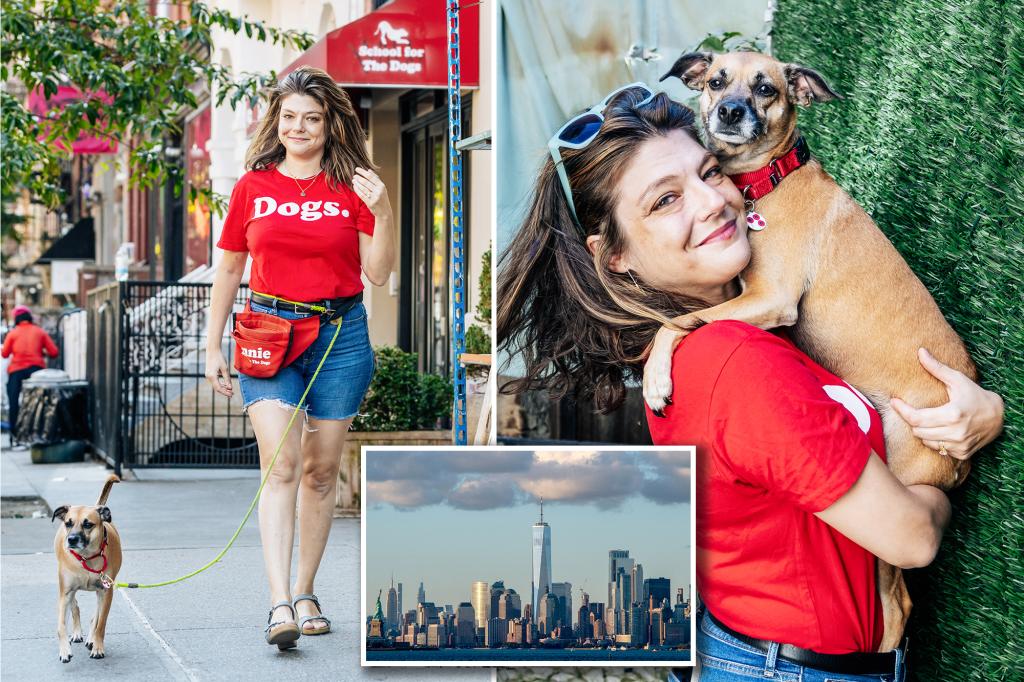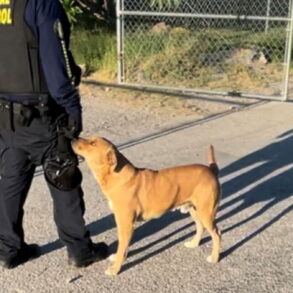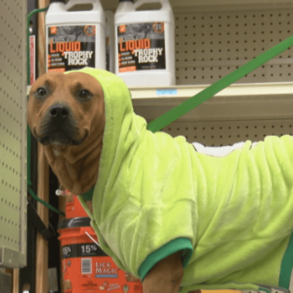
City living is ruff.
Local dog trainer Annie Grossman doesn’t just teach pups to be obedient and well-mannered, she also giving them coping skills — from walking calmly amidst sirens and loud construction noises to sitting pretty in subway carriers — for life in the Big Apple.
“If your dog can make it here – they can make it anywhere,” Grossman told The Post. “You’re swinging with a weighted bat if you’re training a dog who can exist in New York City.”
Grossman, the owner of School for Dogs in the East Village, has trained thousands of dogs, including those owned by stars such as Amy Schumer, Olivia Wilde and Jim Gaffigan. And, she has a new book, “How to Train Your Dog with Love + Science,” out now.
She said New Yorkers need to focus on the unique aspects of city life when it comes to Fido’s education.
“So much about understanding dog training is understanding that environment is everything. The environment is essentially controlling the behaviors of your dog,” said Grossman, who also regularly works with rescue dogs from afar who are being adopted by Gothamites.
Urban leash walking is a key skill. At her school, makeshift obstacle courses of cones and toys are used to mimic the stimuli of busy street corners, strangers and passing dogs.
Grossman once coached a pup through the agility course after it suffered a scary mishap when the pup gobbled up a chicken bone off the street in Soho, resulting in a pricy vet visit and surgery.
What can pet owners do at home to help their dogs with city life? Here, Grossman offers some guidance.
Volume control
Dogs can learn to live with the sounds of New York through classical conditioning, or, as she describes in her book, “learning by association.”
Grossman suggests playing the sound of a siren at low volume in your home, perhaps in the kitchen or wherever your dog eats.
Give Fido a treat as the sound plays, then gradually increase the volume, giving more tasty snacks.
“Whenever possible its a good idea to pair things with treats,” she said. “Dogs are making associations 100% of the time. A lot of the associations that become meaningful are the things dogs associate with food.”
Sidewalk social
City pups need to be comfortable walking amidst strangers — including strange dogs.
First, Grossman says, get an idea what distance your mutt is comfortable passing another dog. Then build comfort getting closer by moving toward another dog and giving a treat.
“[The thought is] when I orient toward another dog – I’m going to get something good,” she said.
In some instances though, it’s OK for Fido to be scared and want to avoid an intimidating dog. Practice turning around so in the heat of a moment, such a maneuver isn’t stressful.
“Teaching the owner and dog to do a seamless U-turn so when you have to do that in a stressful moment they’re not going berserk at the end of the lease,” she said.
Table manners
Grossman uses half-sized yoga matts to train pups to sit and stay – even in high stimuli settings like a busy outdoor restaurant.
“Put the mat down on the ground and give your dog a treat when they go there. Wait three seconds for your dog to do something where they appear a little more relaxed – like sit down, lay down, then give another treat,” she said.
“The idea is to be teaching them the behavior of relaxing is a good thing. Like any other behavior you can break it down by tiny bits. That ‘sticky spot’[like a mat or dish towel] is something you can then bring with you as a security blanket for your dog while you’re out.”
Working treats, like a Toppl, a mentally-stimulating contraption where the dog must work to get the treat out of the toy, are also a good way to incentivize the behavior that come in handy at restaurants, Grossman says, advising up owners to bring the toy to the restaurant.
Subway creatures
Toting around a dog on the subway can be a battle for pups who resist their carriers, so Grossman suggests practicing with an open faced tote and working up to the carrier.
“Start by having a tote that is cut down and incrementally work to have your dog go into a bigger bag,” Grossman said, noting that having a treat in the bag can also help.
“Some dogs might need extra steps – literally making the bag as low key as possible. Having your dog put one foot in the bag, then two feet, then all in.”
This post was originally published on this site be sure to check out more of their content.








































